|
Nelson Class Fleet Battle Ship By Bryn Monnery, Laurent Esmiol and D Hebditch |
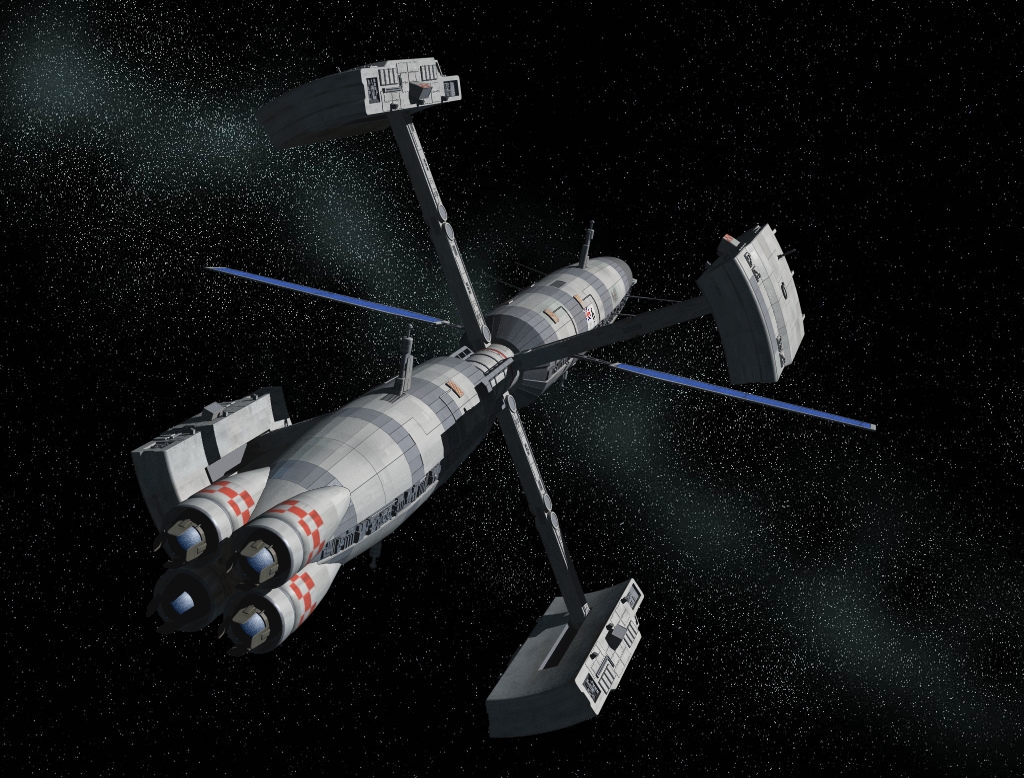
|
Nelson Class Fleet Battle Ship By Bryn Monnery, Laurent Esmiol and D Hebditch |

|
Above: HMS Nelson (note NE pennant) cruising in the Alpha Centauri system. (RJSF MAO) Narrative 'Captain. Sensor One. I have movement by Bandit Group One Five Alpha. Heading out-system at flank 145 Mark 087, tracking for Bravo Charlie Victor.' 'Keep tracking. Helm One prepare to match that track, we'll clip the shelf on our way round. Data inform Flag I believe that Kingfisher may have been compromised and are moving to gain a position to aid his extraction.' ... 'Sensor One. I have Kingfisher. He's reporting a merchant is inbound from Bravo Charlie Victor and the Bandits are closing in on him. Merchant broadcasting that he is light and running ahead of a Bandit Task Force heading into Kilo Mike Juliet. He is estimating task force size figures twenty, ETA possibly Mark Plus Two Hours.' 'Data One. Merchant is French Registered named Pegase. Codes are out of date but correct for Pegase within time frame. We have no signature profile on-file but performance is correct for his class running empty.' 'All hands prepare for action. Helm, we'll come in from the rear of Pegase, that should buy us a couple of seconds grace. SWO, stand-by for a multiple target engagement, I don't want to get swarmed. Data, grav pulse to flag to expect visitors imminent and tell Kingfisher to watch our back.' 'Lets see if we can start evening up the odds a bit while the Bandits are concentrating on that merchant. We can't pass up the opportunity to go shark fishing when we have some live bait handy can we?' Extracts from Command Log HMS Nelson. Operation ENTENTE |
|
The Nelson Class of ships were developed in the 2270's as part of the fleet build up in response to the increased tensions that would eventually lead to the 3rd Rio Plato War. The prime concern at the time was to replace the ageing, obsolete Vanguard Class of warships that were becoming embarrassingly decrepit and unable to perform their designated role. Although designated as 'cruisers' or 'CG's' in most reference works the British refer to the Nelson's as 'Fleet Battle Ships'. This reflects their role as being the main fighting units within a squadron or larger fleet grouping. It is their job to close with and destroy the enemy and they will rarely be given detached duty taskings. Although during the later stages of the recent fighting against the Kafers they have been utilised in fast, hard hitting task forces with Fleet Fast Battle Carriers like the Prince of Wales or Duke of York. The Nelson's were developed from the work done on the two Revenge Class FBS that preceded them. However substantial advances had been made since the heyday of those venerable ships. Indeed the Nelson's were a considerable improvement, and part of Britain's drive towards an all fusion, all modern fleet. As such she was the first FBS to receive a New Military grade stardrive. In the Nelson British designers achieved the excellent mix of speed, armament and protection, and she is still regarded as a fine fighting ship even 23 years after her design date. The Nelson is 180 meters long, with a 10:1 length: width ratio. The forward and aft sections average 12 meters in diameter, while the central section averages 18 meters with the spin capsules retracted, and 180 meters with the capsules extended. Extending or retracting the spin capsules takes a significant amount of time, and generally the capsules are only extended in interstellar space or designated safe zones. While on operations in a system, and ship operates entirely at zero gravity. Most noticeable were the retracting spin habitats used on the ship. Although complicated and an increased maintenance burden they gave the Nelson's a sleek, stealthy profile. Like the other similarly shaped British FBS the shape of the Nelson Class closed down for action is often commented on. Even Her Majesty Queen Margaret was once overheard to remark that: 'well it does look a bit phallic!' The ships were designed and constructed by British Exospace at their facilities on Wellington Station in the Sol System. The lessons of the four strong Nelson-Class have been incorporated into their successors, the King Christian Class FBS. Engineering The Nelson class are powered by Quantum Industries 240MW Deuterium-Lithium fusion reactors. This powerful reactor contains sufficient fuel for 25 years of operations, and the first unit on the Nelson is due for replacement in 2307. Replacement of a fusion reactor is a major job, as the ship must be stripped and the old reactor removed. Often, most nations do not bother and simply scrap military vessels after the power plant has expired, stripping out the vital components for newer vessels. The stutterwarp is a custom 162MW drive massing 82.8 tons and costing 104 million livre for the computers and power equipment. The tantalum coil (which is not included in the price) was cast in deep space, between the Sol and Alpha Centauri systems, such is the delicacy of the operation. Life Support is total. Some vessels only classify oxygen as life support, requiring the scrubbers, food and water to be carried in the cargo bay, but the Nelson class has an “all in” package. This has proved to be more reliable in the long run. Maintenance is the bane of any complex piece of machinery, and starships are no exception. The Nelson class are fairly easily maintained but still require almost 500 tons of supplies every week to keep running at maximum ability. If supply line strain, the engineers must keep vital systems running, and the vessels performance drops of massively. As the Nelson was designed as a FBS, it was deemed that only the minimum of supplies should be carried, and the Nelson has a range from a base of 10 weeks. Below: 3rd Battle of Henry's Star. 4.5 seconds after the first missile strike the already battered Nelson takes the hit that finally kills her. Only 35 crew members servive. (RJSF MAO) |
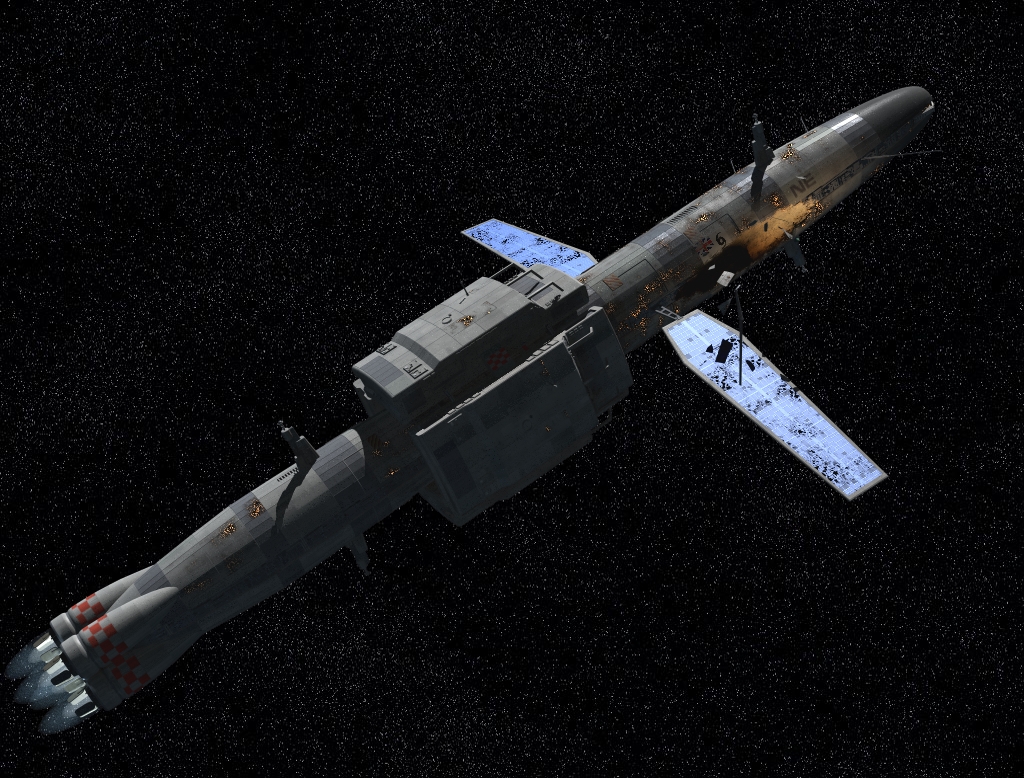
| Operations Sensor Operations The Nelson has a large array of sensors at her disposal, including a large passive sensor array. The array can focus over 300 square meters of sensor elements at almost any point in the sky. However, this array takes a significant time to sweep, and so may only be focused on a small area of space at any one time. Although heralded as a major advance it has proved cumbersome in most situations and was not installed in later classes of ships. It does allow the ship to 'snoop' very effectively when on piquet duty. This array is backed up by a smaller, more conventional array providing a complete spherical scan constantly. The spherical array also has an ESM capability, which the large directional array lacks. The active array is a standard model, drawing 6 MW from the power plant. It is a phased array, and may either conduct a general spherical scan, or may scan much smaller regions of space, minimising the effect of enemy ESM. In addition to her tactical sensors, the Nelson has an array of operational sensors. Deep System Scanners and a Gravitational Array may detect vessels far beyond the range of the tactical systems. Finally, the Nelson class mounts one of the most modern survey suites money can buy, which is hooked into the planetary bombardment system. Defensive Operations The Nelsons, like most similar ships of her class have a large array of defensive hardware mounted on them. Since the best way of avoiding attack is to be invisible, the Nelson class has a stealth optimised hull. This absorbs radar energy, re-radiating it in other wavebands. The heat from the reactor must obviously be radiated from the hull, and the Nelson has a large radiator array selectively radiating heat in several directions. By cutting the emissions the enemy can pick up on, the stealth characteristics of the Nelson class are much improved. Should the Nelson be detected, the Electronic Countermeasures (ECM) suite may come into play. While only active sensors may be jammed, all fire control systems are active in nature. The Nelson mounts several ECM systems, all designed to break active sensor and fire control locks. These systems come under the heading of the “Deceptive Jamming System”. Additionally, the Nelson mounts a noise jamming system, which is rarely used since she is capable of carrying Noise Jamming Drones. These units broadcast static on enemy wavebands, including those used for passive sensors. Should the target lock penetrate the ECM, then the active defence systems come into play. The sensors will attempt to establish a target lock on incoming missiles and ships, handing the locks off to the Fire Control System (FCS) which will spike each incoming with at least one Fire Control Radar (FCR). As the targets come into range, the ships laser cannon and gallowglas system will engage it, attempting to shoot it down. Should the active defences fail completely, the weapon will fire on the Nelson. The Nelson has a powerful modern screening system, which can absorb some of the fire. Screens are clouds of ablative particles, which may absorb the energy of the strike. The RSN refers to screens as “Chaff”. The Screen system has 6 separate chaff launchers, each with 36 chaff canisters. The canisters mass 40 kg each, and are not a significant portion of the systems 60 ton mass. Finally, if the strike connects with the ship, the sacrificial ablative armour may stop most of the energy reaching the internal workings of the ship. The hull is composed of 20 centimetres of Johnson-Massingham Composite, the standard armour material for larger RSN vessels. Tests show that approximately 50% of the time this armour is successful in stopping the explosion reaching the interior. Should the armour fail, millions of joules of energy are transferred to inside the ship. The effect is similar to a High Explosive artillery shell, with a large part of the ship subjected to damage. At this stage the ships Damage Control Procedures come into effect. 29 crewmen are assigned to Damage Control teams. Since the ship is depressurised in combat, and everyone is required to wear a P-suit (either a shipsuit for crew at stations or a worksuit for engineers and DC teams) this is a very demanding task indeed. Offensive Operations The Nelson class mounts the standard British Longbow missile for offensive operations. The ship has 6 launchers, and 6 magazines. Each magazine can carry 112 cubic meters of ordnance in ready launch cradles, and each launcher can accept most RSN ordnance, assuming it is small enough. Standard practice is to half fill each magazine with Longbows (4 each), while the rest is left to other ordnance. This is due to the relative rarity of missiles. The RSN currently has 810 Longbows in its inventory, not enough to offer all ships a complete reload. However, ships carrying out special missions (such as Operation ENTENTE) often find additional ordnance available, and the magazine system allows them to field it without withdrawing from battle. A remote pilot commands each Longbow missile launched. It is their job it is to bring the weapon within strike distance and select the attack option used. Due to active defences it is preferable for the incoming missile to be undetected. To achieve this, the missile must be launched close enough that the target’s sensors will not acquire a lock in time, while getting too close would allow the enemy to do exactly the same. It is for this reason that the major powers are producing fast ships and missiles, not for any ideas such as 'outrunning missiles'. A tactical concept that has increasingly had its day and has been badly exposed in combat on a number of occasions against the Kafers. Planetary Operations In British doctrine planetary support operations are conducted by two main elements of the RSN, small fighter craft (the Wellington especially) and heavy Battle Craft. Other lighter escort ships have been found to be too vulnerable in that dangerous arena and no space force would risk a Battle Carrier in low orbit. Consequently the Nelsons have several ways to 'Reach out and touch' a planet. Obviously, her lasers may shoot down satellites and her barrage jammer may blot out much of a planets communication activity. In addition a Nelson carries a number of Striker missiles. These are ground attack/kinetic kill ordnance and may be unleashed from a very high orbit. Finally the ship is designed to carry a small complement of troops. Normally this is only occupied by a 20 man 'Fleet Party' at most however each Nelson can carry an 80 man company and 3 landers to carry them. These troops are normally found from the 'Red' Royal Marines but have been found from a number of sources including the British Army and the forces of Britain's allies. Indeed HMS Ramage has in recent months embarked a company from the Canadian Special Service Force's No.5 Commando. Below: Nelson on her post-refit cruise in the Sol system in 2297. (RJSF MAO) |
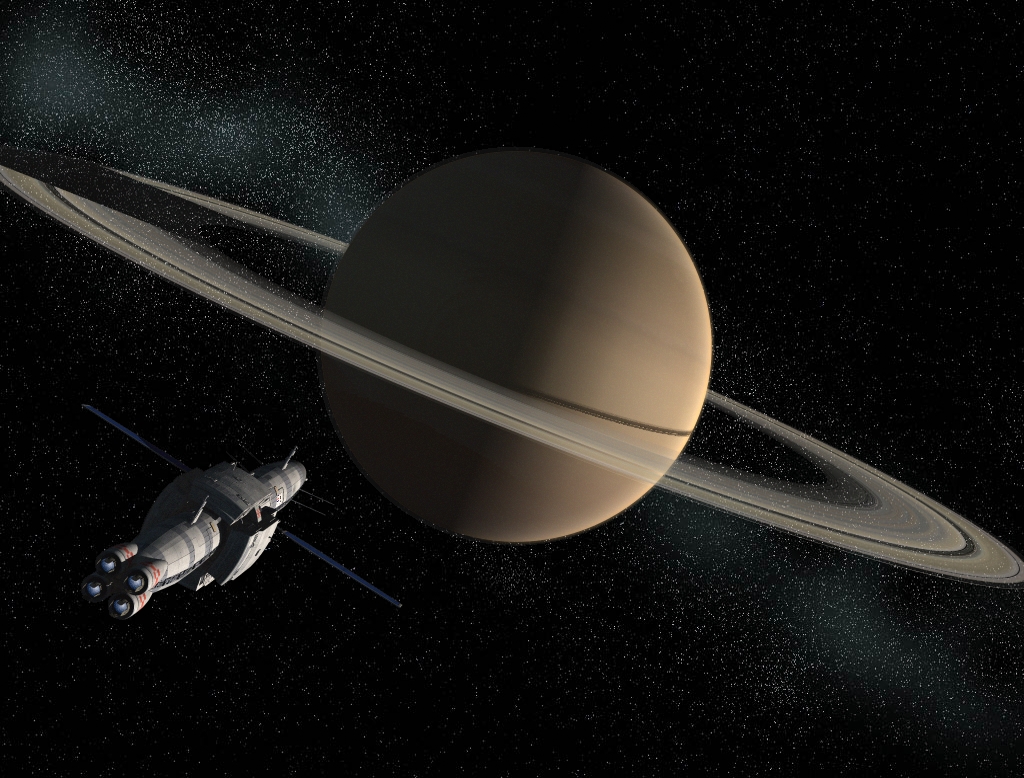
| FBS-06 HMS Nelson
HMS Nelson is the lead ship of the class and was laid down in 2278 and came into service with the RSN in 2282. Almost as soon as she was accepted into service she was deployed onto the Chinese Arm in response to increased tensions that would contribute to the Central Asian War. Indeed the ship's troops from Nelson were called upon to intervene during the 'New Boxer' rebellion on Han Shan. One of the ships landers was shot down during the operations with the loss of 37 crew and Japanese troops. The ship was then assigned to the Home Fleet in the Sol System for three years, partly due to problems with systems integration that plagued the ship throughout its service. In 2285 whilst docked at Clarke Station the ship was the target of a Manchurian commando assault, presumably in response for the ship's role at Han Shan. The attempt was foiled by the resident Zeebrugge Group detachment but no prisoners were taken. In 2286 Nelson was transferred to the so-called 'Neutrality Patrol' that escorted friendly shipping along the French Arm in the face of Manchurian privateer activity, but saw frustratingly little action. Nelson was a frequent visitor to the French Arm and was deployed to the 61 Ursae Majoris system during the War of German Reunification. In spite of some Franco-German 'shadow boxing' this period was relatively peaceful as most of the belligerents assets were deployed elsewhere. Indeed the British squadron had more problems with the antics of the semi-legitimate Elysian Space Force. In 2294 the Nelson returned to Sol for a three year long refit and overhaul, after which she was assigned to Queen Alice's Star where she remained until the Kafer Invasion. Although stood-to to deploy up-Arm with Commodore Connors' Expeditionary Squadron Nelson instead formed a major part of the British Combined Fleet and later the Terran Reserve Fleet. There then followed a frustrating period for the crew as they were held firm in reserve at QAS whilst colony after colony fell to the Kafers and human forces were badly mauled. For Nelson and its urbane, ruthless Captain Mitchell this was to change with Operation ENTENTE, the evacuation of Kimanjano. As part of Task Force Green, HMS Nelson was part of the space force screen that covered the vulnerable troopships uplifting from the planet. Initial skirmishes resulted in a stand-off between human and Kafer forces which ended when reinforcements arrived from BCV. Nelson was acting as a reserve for the thin screen of frigates and privateers covering the system approaches and was first into action destroying a squadron of Kafer fighters. The 2nd Battle of Kimanjano lasted a full eighteen hours as the British, French and American warships fought to buy time for the troopships. Nelson was heavily and repeatedly engaged and could always be found where the fighting was fiercest. Inevitably the ship's luck ran out and it took a devastating hit to its main data systems, temporarily disabling it. The Kafer ship tagged Alpha-77 (later found to be the 'Spirit of Conflict') then closed with the Nelson in an attempt to board, but the British ship had by then switched to its alternate systems and destroyed Alpha-77 with a swarm of kinetic kill missiles. Nelson was then able to limp out of the system under its own steam, protected by a pair of American cruisers of the rear guard. The damage to Nelson was severe, but not crippling, and facilities at QAS were able to bring the ship back to full repair. Casualties from the battle at Kimanjano had been light and the crew learned much from the experience. Morale amongst the crew was very high, reflecting the prestige of the ship, a fact resented by other allied warships. Nelson was present for the defining Battle of Beowulf and once again had a good battle, avoiding serious damage whilst being in the thick of the fighting. Towards the end of the battle the ship gave close support to the USS Columbia helping to keep other Kafer ships away from that vessels epic duel with the Delta 'Ecstasy of Struggle'. Indeed both the Nelson and fighters from the Ark Royal claim to have delivered the coup de grace to that warship. Nelson was immediately available to take part in Admiral Graham's pursuit of the broken Kafer forces and fought again at the 3rd Battle of Kimanjano when Triumphant Destiny's fleet was hammered apart. The ship then went on to assist in the 3rd Liberation of BCV-4, providing orbital bombardment support to human ground forces. The Nelson had by this stage gained a reputation as a lucky ship, however in its next operation that luck ran out. An Anglo-French Task Force under Admiral Bell had been bolstered by the Canadian Expeditionary Squadron and had been tasked to clear the Henry's Star system and land reinforcements on Crater. At Henry's Star they unexpectedly found Kafer Task Force November that had evaded the main fleets of Rochemont and Graham. The 3rd Battle of Henry's Star was a bitter one for the Nelson. The Duke of York Battle Group launched into the system via a covered approach, before falling on the Kafers from the sun. The Nelson was in the crucial left ecliptic flank position, covering the main approach to the BG’s fleet train, and troopships. The Kafers launched their main thrust at the Nelson, with a Beta class Battleship and over a dozen attack craft. The Nelson fought a brilliant action, destroying the Beta and virtually the entire Kafer fighter force, however in the confusion of the fight the ship became isolated and took the full brunt of the Kafer missile response. The ship was eviscerated inside ten seconds, with nearly two thirds of the crew killed instantly and the ship left dead in space. The evacuation was called after attempts at damage control proved fruitless and led to the loss of more of the crew. Only 35 of the 147 crew were recovered after the successful conclusion of the battle, including the badly wounded Captain Mitchell. The Kafers concentration on the Nelson had left the rest of the Task Force with an easier job to do but at the expense of the Nelson. The ship's hulk is still in the Henry's Star system but during its eventful career the Nelson had proved one of the finest fighting ships in the RSN. Crew Quality: +4 (On destruction, 2302) |
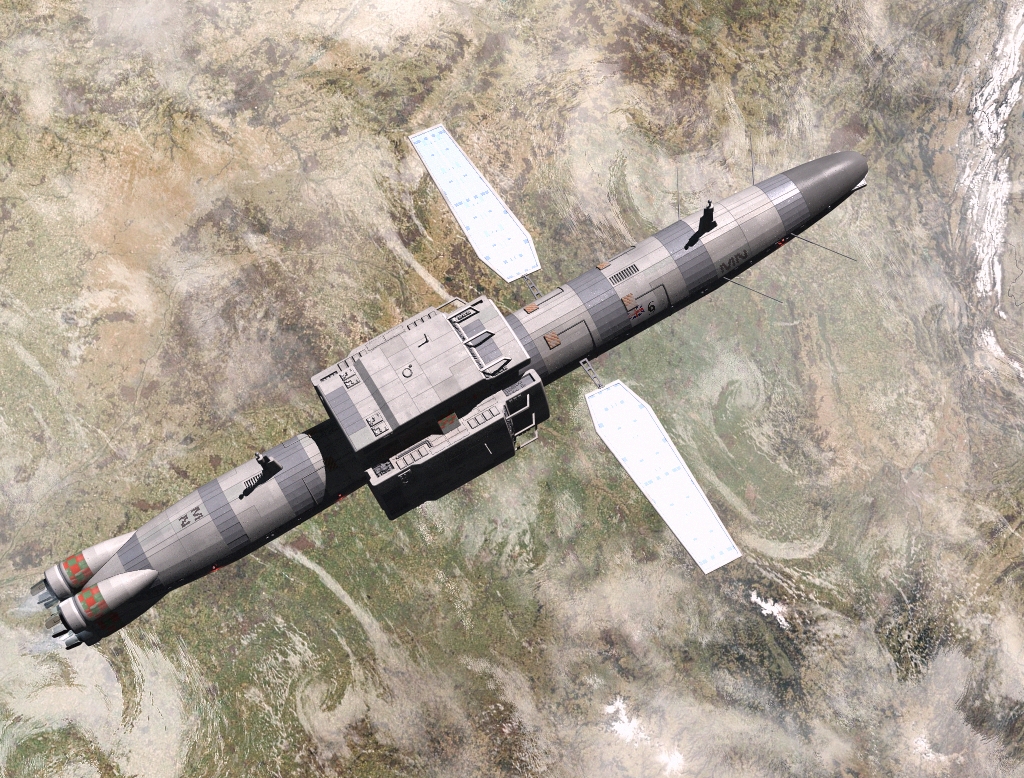
| Above: 'In Harms Way'. HMS
Montrose preparing to give orbital bombardment
support to ground troops above the German Continent of BCV-4 in August
of 2302. (RJSF MAO)
FBS-07 HMS Montrose
The Montrose was laid down in 2281 and commissioned into service in 2284. It was a period when British capital ship production was accelerating in the light of increasing global tension on Earth. The Montrose was soon assigned to the Neutrality Patrol at a time in the Central Asian War when Manchu privateers and light warships were plaguing merchant traffic on the French Arm with raids from secret bases on the Frontier. Alongside warships from other neutral nations the NP was responsible for escorting merchant convoys. Montrose was involved in the infamous SOL-BCV 314 convoy incident, harassed by terrorist attacks at stations the 26 vessel strong convoy was ambushed on the Kimanjano approaches by a mixed squadron of Manchu privateers and regular warships. Split and out-manoeuvred it fell upon the Montrose and the Australian Canberra to defend the convoy. These powerful warships finally managed to gain the upper hand but four of the convoy were boarded by the privateers and taken as prizes. Although two Manchu warships and two privateers were destroyed in the action Captain Moran of the Montrose was pilloried in the press and was forced to resign over the loss of the merchants. The ship returned to Sol for after-action repairs and was then assigned to the Home Fleet for seven years before entering refit in 2295. She was then assigned to QAS where she would work alongside her more glamorous sister-ship Nelson. Like Nelson the ship was held at QAS during the initial stages of the Invasion, and also participated in Operation ENTENTE with the main body of Task Force Green. Steady and unspectacular Montrose provided a key element of the action, hitting and fading as part of Rear Admiral Green's plan. As Montrose's landers had been reassigned to some of the merchant ships aiding the evacuation process she was able to take on-board some of the remaining Martel fighters which had remained in-system in hidden bases, harassing the Kafers since the original invasion of Kimanjano. These fighters and their elite crews were a welcome addition to the defence of Beowulf. During the Battle of Beowulf the Montrose was in the Victory Battle Group being assigned to act as 'goal keeper' for that Fleet Battle Carrier and Admiral Graham. Throughout the battle Victory and its shadow were never far from the action as Admiral Graham used the Task Force as a mobile reserve bolstering hard pressed areas of the defence. This astute use of his assets meant that the Montrose was on hand at the pivotal moments of the battle, indeed when HMS Victory was forced to withdraw because of damage Graham transferred his flag to the Montrose and it was from this ship that he saw his victory become complete. Although not suffering any catastrophic damage in the fighting, thanks to its heavy armour and shielding, the Montrose had been badly battered and was unable to take part in the immediate follow up and the 3rd Battle of Kimanjano. Repairs were undertaken above Beowulf and the ship rejoined the fleet within a month and was stationed above Beta Canum. Due to return to the Home Fleet the Montrose has been forced by the destruction of the Nelson to remain in-theatre for the time being. The ship remains under its Captain Sir Alexander Carlton who has a reputation as being a solid and un-inspirational officer. However he is a close friend of Admiral Graham who holds him in high regard. The crew of the Montrose are well trained and drilled and now have an excellent bank of combat experience in high intensity operations. However the ship has never had the reputation of its more flamboyant sister-ships, something the crew are quite proud of, never yet having to suffer the casualties incurred by the doomed Nelson or Rodney. Crew Quality: +3 (2303) Below: HMS Montrose on patrol in the BCV system in september 2302. (RJSF MAO) |
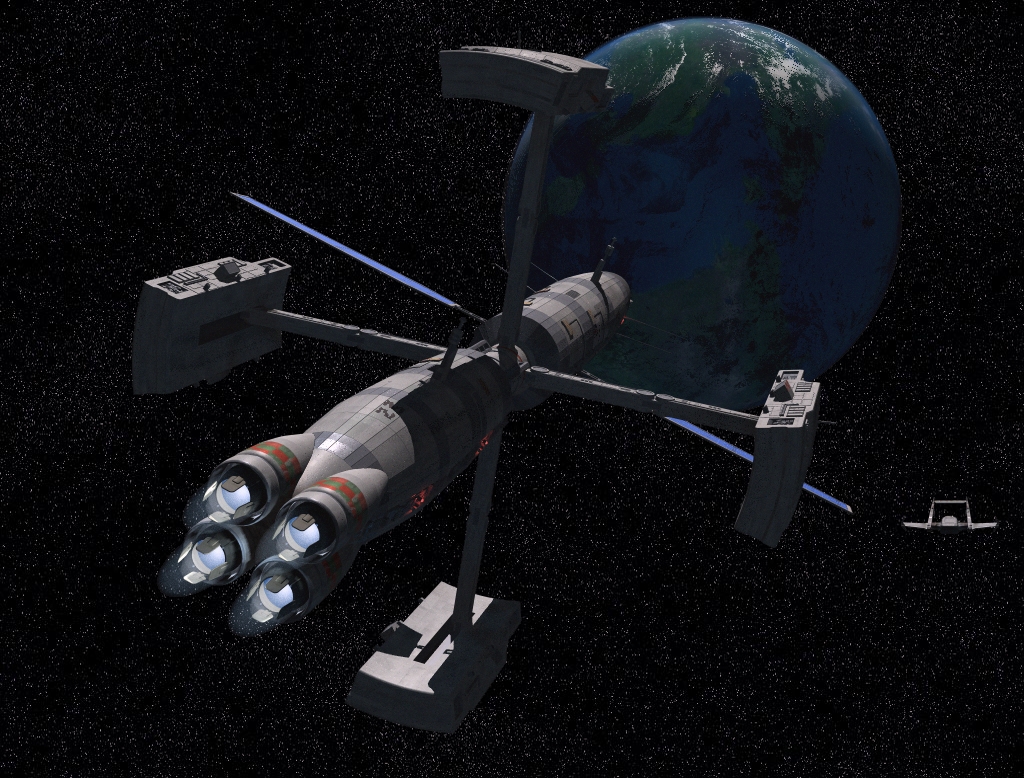
| FBS-08 HMS Ramage
HMS Ramage is named after the most renowned of Britain's space explorers of the second half of the 22nd Century. Alongside similarly flamboyant figures and rivals from France and Bavaria Ramage opened up what is now known as the French Arm. This so-called 'exploration race' was instrumental in Britain, France and Germany's current position as the 3 pre-eminent powers on that arm. An appreciative Queen Alice created an order of Knighthood specifically for explorers, the Order of Queen Alice's' Cross (KAC) in response to the public acclaim Ramage was garnering. Although his reputation has declined since his death thanks to revisionist biographies he remains an iconic figure for a revitalised British nation. As an RSNR officer it was deemed appropriate for one of Britain's most modern warships be named after him. The Ramage was laid down in 2283, on a specially constructed new frame at Wellington Station and commissioned 2286. She served in the Home Fleet during the Central Asian War and saw no action either with the Neutrality Patrol or on Piracy Suppression after the war. Instead the ship was posted to the RSN's Astrographic Service in 2289 to participate in a joint mission with the Royal Society and FPK. This involved for a deep probe mission to Betelgeuse, as at the time neither body had a functioning deep space exploration craft capable of undertaking the journey. (This would inspire the FPK to produce the two Ashton-Class vessels. Ironically one the De Lancey was mobilised by the military during the Kafer War.) She returned in 2294 with extensive data on Red Supergiants. This data was hoped to provide a way of discharging at Arcturus and opening the French Arm into the Serpenti Cluster. The raw data from this research is now under additional scrutiny, with the priority being on breaching Kafer Space. (In late 2301 a breakthrough was achieved, and a new generation of LaFarge shielding, known as Abraham Shielding was developed. This allowed discharges at Arcturus directly. The first 3 ships to receive the new shielding were the 3 Killiecrankie class naval pickets under construction.) Ramage had an even more extensive refit than the others, lasting from 2295 to 2300 as the unique scientific modifications she had undergone were removed. In addition the ship gained more crew members and underwent a series of training exercises to gain certification in the ships main mission. Ramage was on station with the Home Fleet when the second invasion was launched and moved with the reinforcements to Queen Alice's Star in February 2302. Her belated arrival left her with little work-up time when compared with other units of the Terran Reserve Fleet. Consequently she was assigned to the close protection of the two Fleet Attack Carriers Joffre and Ark Royal whose flotillas of fighters would provide the means to nullify the Kafer's advantage in small craft. This was the ship's role during the Battle of Beowulf when numerous attacks by Kafer fighters and Epsilon Class ships were launched at the carriers. Ramage and the other ships of the protection group stood firm, reinforced at times of major pressure by the dangerous Prince of Wales Battle Group. The Ramage was not badly damaged in the battle, although one hit killed twenty of the crew, and took part in the 3rd Battle of Kimanjano where she was responsible for the destruction of the badly damaged Alpha-65 ('Invincibility of the Sense of Race'). During the Liberation of Kimanjano she provided low orbital bombardment support for Azanian forces, her heavy armour protecting her in that highly dangerous environment where the lighter escort ships had to retreat. She was also present at the Liberation of BCV-4 before being transferred to Rochemont's Fleet to relieve the battered RSN ships that had been serving with it since the start of the war. Consequently the ship saw frequent skirmish action along the bridge of stars out to Aurore. HMS Ramage remains attached to Rochemont's Fleet which has responsibility for the defence of the Eta Bootis finger and can usually be found either at Eta Bootis or at Hochbaden. Rumours in the defence community suggest that the ship has been slated for participation in operations beyond Arcturus or into the Wolf Cluster where Ramage recently escorted HMS Normandy on an undisclosed operation. Captain Jane Clark has commanded the ship for the last three years and has gelled the crew into an effective fighting unit. The ship's participation in mopping up operations has given it solid experience in anti-Kafer operations although not having fought the Kafers at the height of their power they can be somewhat blasť about the strength of the opposition. Crew Quality: +2 (2303) |
| FBS-09 HMS Rodney
Rodney was laid down in 2285 the last of the four Nelson Class vessels as the UK's large warship building programme began to wind down once the Central Asian War erupted in favour of smaller strike and escort vessels and the larger Battle Carriers. The Rodney was constructed with an integral Flag Bridge and enhanced command and control facilities that would enable it to act as a flag ship during expeditionary operations. All of the Nelson Class later received this facility as part of their refits. HMS Rodney was completed too late to see any action during the CAW and instead was stationed initially with the Home Fleet. With the outbreak of the German Reunification War she was transferred to the Tirane Squadron to bolster that force in the face of increased skirmishing in the system caused by the succession of Freihaven and the declaration of neutrality by several units of the Bavarian fleet. It was an interesting time for the Tirane Squadron as activity around Alpha Centauri was at an all time high with surveillance operations, deceptions and 'tip and run' raids being conducted by a range of agencies in the outskirts of the system. These incidents were rarely reported in the media. Rodney remained a stalwart of the Tirane Squadron until called upon as a reinforcement for the Reserve Fleet at QAS. Her existing captain was replaced by Captain Philip Witterman, a rising star of the RSN who had distinguished himself in piracy suppression on the Chinese Arm commanding the Ulysses. The Rodney arrived at QAS in January of 2302 but didn't take part in Operation ENTENTE. The Rodney's first combat action was her last. During the Battle of Beowulf the ship was attached to the USS Columbia Battle Group as the American Kennedy Class Missile Cruisers were being employed on the flanks of the battle. After Columbia BG's initial missile duels it closed to broadside range with a large Kafer force composed of veteran ships of the Invasion in order to 'fix' it and open it to hit and run attacks from other human units. Rodney engaged the infamous Improved Alpha Class known as 'Bloody Claw' (actually 'Glory of the Vah') that had been responsible for the destruction of at least three human warships. Rodney pounded the Kafer battleship totally, destroying her after several lucky strikes. At this stage of the battle the USS Columbia was deeply engaged in its legendary duel with 'Triumphant Destiny's' 'Ecstasy of Struggle'. All of the Battle Group's ships had taken heavy damage and the formations began to break up as ships were killed and others engaged in individual duels. In endeavoring to give aid to the Columbia the Rodney was isolated and cornered by two Kafer Battle Ships. The Beta Class 'Genocide of the Barbarians' especially outmanoeuvred the labouring British ship and inflicted heavy damage and left the ship dead in space. The evacuation of the ship could only take place after the arrival of Prince of Wales and its supporting ships which drove away the 'Genocide'. Captain Witterman died on board his ship alongside 98 other members of the crew. However the hull is still repairable, and RSN salvage teams from Churchill Station boarded her 5 days after the battle and towed her into Beowulf orbit. She is now waiting for a larger tug to arrive to tow her to Earth, where she may be re-fitted. Crew Quality: +2 (On destruction, 2302) Below: HMS Nelson on post-refit cruise in the Sol system in 2297. (RJSF MAO) |
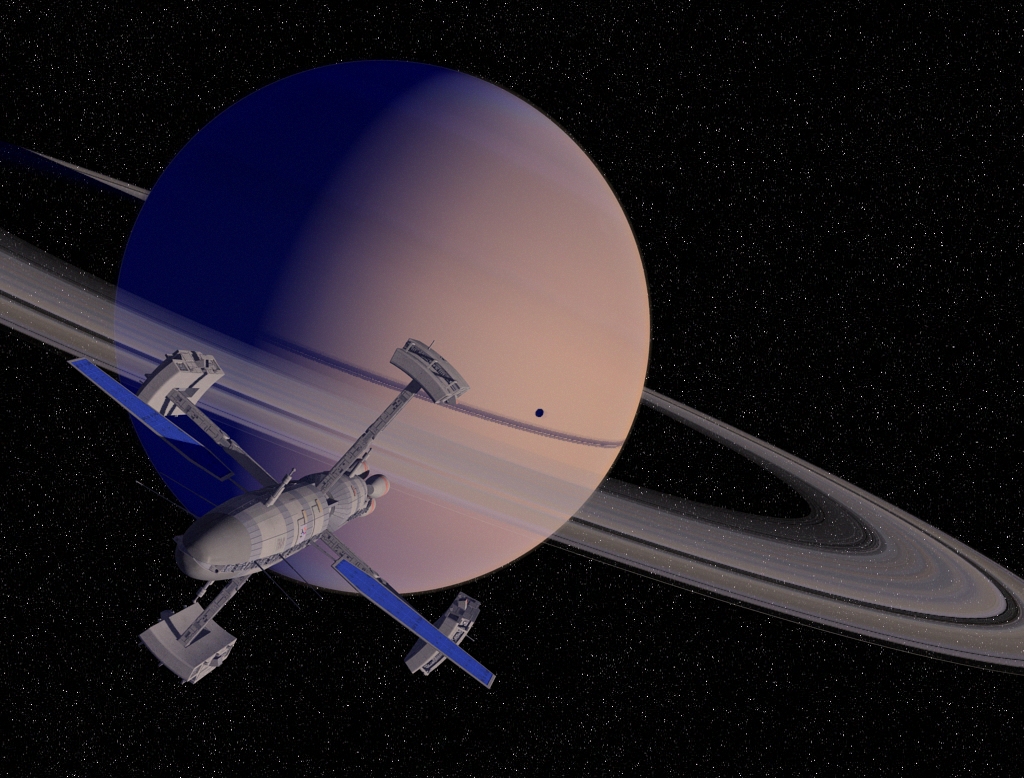
| Stats British Nelson Class Fleet Battle Ship
Performance
Ship Status Sheet
Weapons 18 x1+1dbl lasers in jack turrets (6x
123, 3x 345, 3x 567, 6x 178) Ordnance Load 6 Launchers feeding from 6 crossloading magazines. Each magazine usually contains 4 Longbow missiles and 8 Striker ground attack weapons Sensors and Electronics: Phased Active-16 with redundant antenna Crew Hits: Damage Control: 28 Below: HMS Nelson pulling away from Kimanjano during the closing stages of Operation ENTENTE. This is not a staged photo, consequently the Harriers from HMS Prince of Wales are passing exceptionally close to the ship. (RJSF MAO) |
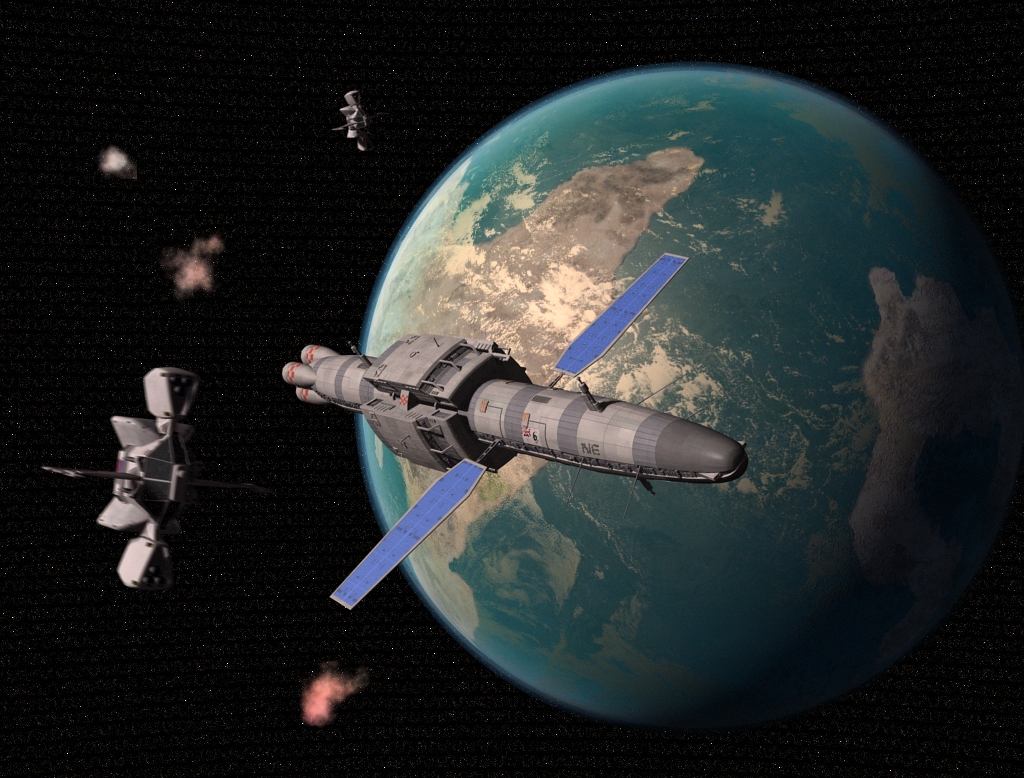
| Weapons British City Class Spaceplane
The City is a essentially a smaller version of the Wessex Lander carrying a single platoon of raiders or commandos rather than a full company. During the Kafer War, the main use of the City was for Strike Ships to deliver small raids on Kafer held worlds or to perform supply drops. It was intended for many of the Cities to be replaced by the newer, much more capable Ravens but this was not to be following the rapid expansion of the Assault Landing Group which had priority on these craft. Although on occasions units of Ravens from the 1205 NIS tasked with supporting special operations would be deployed onto FBS. Performance
Ship Status Sheet
Weapons: None Sensors: Navigation Radar
Damage Control: N/A British Gallowglas Point Defence System Developed by Woolf Industries for the Texan Space Navy, the Gallowglas is a common upgrade to RSN ships. In essence it is a Submunition Launcher but the munitions are optimised for defensive fire against missiles rather than striking enemy hulls. However they are still more than capable of engaging ship sized targets.
British Longbow Missile
Replacing the Starburst as the standard British Attack missile, the Longbow carries a heavy warhead and an Semi-Independent tracking system like the SIM-14. Combat Performance Data
Design Characteristics
Notes: Due to the small hull size, Passive-7 is the largest sensor that can be fitted without installing a proper folding array. This assumes the large conventional “missile like” form I’ve given her. As a comparison, all in, a SIM-14 costs MLv20.2, including a standard folding array passive sensor. British Striker Ground Attack Missile The Striker is a long range non-stutterwarp missile used to attack either ground targets, or space stations. The warhead masses 1 ton, the guidance package is negligable (5kg), the remaining mass is the booster. The weapon has a range of 3,600km, and so may be fired from an extremely high orbit. Type: Starship Launched Ground Attack
Missile
|